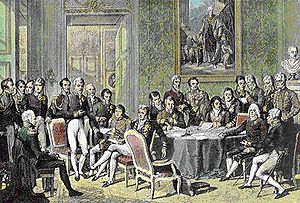Congress of Vienna
The Congress of Vienna was a conference of ambassadors of European states chaired by the Austrian statesman Klemens Wenzel von Metternich, and held in Vienna from November, 1814 to June, 1815. Its objective was to settle the many issues arising from the French Revolutionary Wars, the Napoleonic Wars, and the dissolution of the Holy Roman Empire. This objective resulted in the redrawing of the continent's political map, establish the boundaries of France, Napoleon's duchy of Warsaw, the Netherlands, the states once part of the Confederation of the Rhine, the German province of Saxony, and various Italian territories, and the creation of a spheres of influence through which France, Austria, Russia and Britain brokered local and regional problems. The Congress of Vienna was a model for the League of Nations and United Nations due to its goal to constitute peace by all parties.
 The immediate background was France's defeat and surrender in May, 1814, which brought an end to twenty-five years of nearly continuous war. Negotiations continued despite the outbreak of fighting triggered by Napoleon's dramatic return from exile and resumption of power in France during the Hundred Days of March-July, 1815. The Congress's "Final Act" was signed nine days before his final defeat at Waterloo on June 18, 1815.
The immediate background was France's defeat and surrender in May, 1814, which brought an end to twenty-five years of nearly continuous war. Negotiations continued despite the outbreak of fighting triggered by Napoleon's dramatic return from exile and resumption of power in France during the Hundred Days of March-July, 1815. The Congress's "Final Act" was signed nine days before his final defeat at Waterloo on June 18, 1815.
An unusual feature of the "Congress of Vienna" was that it was not properly a Congress: it never met in plenary session, and most of the discussions occurred in informal, face-to-face, sessions among the Great Powers of France, United Kingdom, Austria, and Russia, and sometimes Prussia, with limited or no participation by other delegates. On the other hand, the Congress was the first occasion in history where on a continental scale people came together in place to hammer out a treaty, instead of relying mostly on messengers and messages between the several capitals. The Congress of Vienna settlement, despite later changes, formed the framework for European international politics until the outbreak of the First World War in 1914.
Sed lacus. Donec lectus. Nullam pretium nibh ut turpis. Nam bibendum. In nulla tortor, elementum ipsum. Proin imperdiet est. Phasellus dapibus semper urna. Pellentesque ornare, orci in felis. Donec ut ante. In id eros. Suspendisse lacus turpis, cursus egestas at sem.

